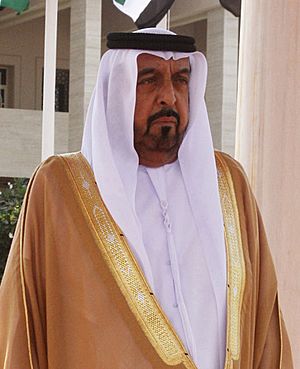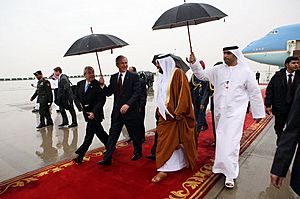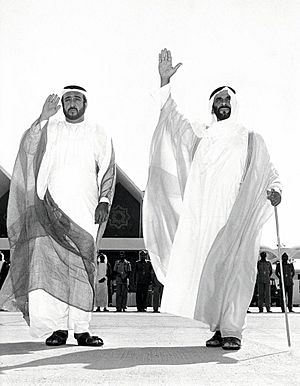Khalifa bin Zayed Al Nahyan facts for kids
Quick facts for kids Khalifa bin Zayed Al Nahyan |
|
|---|---|

Khalifa in 2010
|
|
| 2nd President of the United Arab Emirates | |
| In office 3 November 2004 – 13 May 2022 |
|
| Vice President and Prime Minister | Maktoum bin Rashid Al Maktoum Mohammed bin Rashid Al Maktoum |
| Preceded by | Zayed bin Sultan Al Nahyan |
| Succeeded by | Mohamed bin Zayed Al Nahyan |
| Ruler of Abu Dhabi | |
| Reign | 2 November 2004 – 13 May 2022 |
| Predecessor | Zayed bin Sultan Al Nahyan |
| Successor | Mohamed bin Zayed Al Nahyan |
| 2nd Deputy Prime Minister of the United Arab Emirates | |
| In office 23 December 1973 – 20 December 1977 |
|
| President | Zayed bin Sultan Al Nahyan |
| Prime Minister | Maktoum bin Rashid Al Maktoum |
| Preceded by | Hamdan bin Rashid Al Maktoum |
| Succeeded by | Hamdan bin Mohammed Al Nahyan |
| Born | 7 September 1948 Al Ain, Trucial States |
| Died | 13 May 2022 (aged 73) Abu Dhabi, United Arab Emirates |
| Burial | Al Bateen Cemetery |
| Spouse |
Shamsa bint Suhail Al Mazrouei
(m. 1964) |
| Issue | 8, including Sultan and Mohammed |
| House | Al Nahyan |
| Father | Zayed bin Sultan Al Nahyan |
| Mother | Hassa bint Mohammed Al Nahyan |
| Religion | Sunni Islam |
|
Education
|
|
Sheikh Khalifa bin Zayed bin Sultan Al Nahyan (Arabic: خليفة بن زايد بن سلطان آل نهيان; 7 September 1948 – 13 May 2022) was a very important leader. He was the second president of the United Arab Emirates (UAE). He also ruled Abu Dhabi. He served from November 2004 until he passed away in May 2022.
Khalifa was the oldest son of Zayed bin Sultan Al Nahyan. His father was the first president of the UAE. Khalifa helped lead the country even before becoming president. He took on many duties when his father had health issues.
He became the ruler of Abu Dhabi on 2 November 2004. The very next day, he was chosen as the president of the UAE. As ruler of Abu Dhabi, he brought many cultural and learning centers to the city. These included the Louvre Abu Dhabi and New York University Abu Dhabi. He also helped start Etihad Airways, a major airline.
During his time as president, the UAE grew stronger economically. Its economy, not just from oil, became much bigger. Khalifa was seen as a leader who wanted to modernize the country. He also helped the UAE build stronger friendships with countries like the United States. When there were big economic challenges around the world, he helped Dubai with a lot of money. In 2010, the world's tallest building, Burj Dubai, was renamed the Burj Khalifa in his honor.
In 2014, Khalifa had a stroke. After that, he took on fewer public duties. His half-brother, Mohamed bin Zayed Al Nahyan, took over many daily tasks. In 2018, Forbes magazine listed Khalifa among the world's most powerful people. After his death in May 2022, his brother Mohamed became the new president.
Contents
Early Life and Education
Khalifa was born on 7 September 1948. This was in Al Ain, which was then part of the Trucial States. His parents were Hassa bint Mohammed Al Nahyan and Zayed bin Sultan Al Nahyan. He studied at the Royal Military Academy Sandhurst. This is a famous military school.
His Journey in Politics
First Steps in Leadership: 1966–1971
When his father, Zayed, became the ruler of Abu Dhabi in 1966, Khalifa started his political journey. He was chosen to represent the ruler in the Eastern Region of Abu Dhabi. He also led the Courts Department in Al Ain.
In 1969, Khalifa became the crown prince of Abu Dhabi. The next day, he was put in charge of the Abu Dhabi Department of Defence. He helped build up the Abu Dhabi Defense Force. This force later became a key part of the UAE Armed Forces.
Helping the UAE Grow
After the UAE was formed in 1971, Khalifa took on many important roles. He became the 2nd Deputy Prime Minister of the United Arab Emirates. He also became the chairman of the Executive Council of Abu Dhabi.
In 1976, he became the deputy commander of the UAE Armed Forces. He also led the Supreme Petroleum Council. This gave him a lot of power over energy matters. He was also the head of the Environmental Research and Wildlife Development Agency.
Becoming President: 2004–2022
Khalifa became the ruler of Abu Dhabi on 3 November 2004. He was then elected president of the UAE. This happened after his father, Zayed bin Sultan Al Nahyan, passed away. Khalifa had been acting president before this because his father was unwell.
In 2005, Khalifa announced a change for the Federal National Council (FNC). This council gives advice to the president. He said that half of its members would be chosen by indirect election.
In 2009, Khalifa was re-elected as president. He served for a second five-year term.

In 2011, Khalifa sent the United Arab Emirates Air Force to help in Libya. This was to support efforts against Muammar Gaddafi. He also promised the UAE's full support to Bahrain during a time of unrest.
In 2013, he ordered the building of Azzam. This is one of the longest motor yachts ever built. It is about 590 feet long.
In January 2014, Khalifa had a stroke. He was in stable condition after surgery. After this, he was seen less often in public. His brother, the crown prince, took on more of the daily leadership duties.
During his presidency, in February 2022, the UAE made peace with Israel. They signed agreements on things like tourism and healthcare.
Personal Life

Khalifa was the oldest son of Zayed bin Sultan Al Nahyan. His mother was Hassa bint Mohammed bin Khalifa Al Nahyan.
He was married to Shamsa bint Suhail Al Mazrouei. They had eight children together. Their children are Sultan, Mohammed, Shamma, Salama, Osha, Sheikha, Lateefa, and Mouza.
Helping Other Countries
Through the Khalifa bin Zayed Al Nahyan Foundation, the UAE helped the people of Yemen. In August 2015, they sent 3,000 tonnes of food and aid. By August 19, 2015, the foundation had sent Yemen 7,800 tonnes of food, medicine, and medical supplies.
His Passing
Sheikh Khalifa passed away on 13 May 2022. He was 73 years old. He was buried at Al Bateen Cemetery in Abu Dhabi. His half-brother Mohamed became the new ruler of Abu Dhabi. The next day, Mohamed was elected as the president of the UAE.
The Ministry of Presidential Affairs announced a 40-day period of national mourning. Flags were flown at half-mast. Work was also suspended for three days in many places. Many other Arab League nations also announced official mourning. Countries like Bahrain, Lebanon, Oman, and Qatar declared three days of mourning. Jordan declared 40 days of mourning. Pakistan, Brazil, Algeria, and India also announced periods of mourning.
Honours
| Styles of President of the United Arab Emirates |
|
|---|---|
 |
|
| Reference style | His Highness |
| Spoken style | Your Highness |
| Alternative style | Ra'is |
- Brazil: Collar of the Order of the Southern Cross (2021)
- Spain:
- Knight Grand Cross of the Order of Isabella the Catholic (1981)
- Knight Grand Cross with Collar of the Order of Civil Merit (2008)
- United Kingdom:
- Honorary Knight Grand Cross of the Most Honourable Order of the Bath (2010)
- Honorary Knight Grand Cross of the Most Distinguished Order of St Michael and St George
- The Netherlands: Knight Grand Cross of the Order of the Netherlands Lion (2012)
- South Korea: Member of the Grand Order of Mugunghwa (2012)
- Ukraine: Order of Prince Yaroslav the Wise I degree (2012)
Related pages
Images for kids
See also
 In Spanish: Jalifa bin Zayed Al Nahayan para niños
In Spanish: Jalifa bin Zayed Al Nahayan para niños


